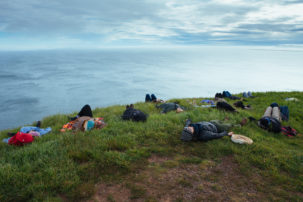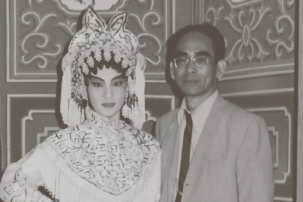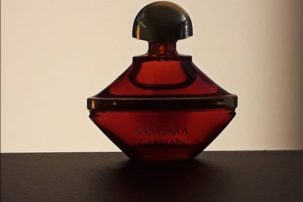The symbolism of snails and slugs has largely come down to three distinct themes: impotence, power and gender; observation of the natural environment; and the act of slowing down, enduring life and inevitably dying.
From what I can recall, my very first art historical lesson came from a 1959 Disney animation in which Donald Duck—dressed as Pythagoras—explained the golden spiral. He did so using a variety of examples from the built and natural world, beginning with ancient Greek sculpture, followed by the Mona Lisa, the Notre-Dame Cathedral—and concluding with many images of snails.
Artists and architects drawing inspiration from natural phenomena designated a variety of roles for snails throughout European art history: as examples of perfect symmetry and intelligent design, oversized nemeses of knights in medieval manuscripts, composite elements of men’s faces in Arcimboldo’s disquieting allegorical portraits, features of still lives from the Dutch Golden Age and as one of Matisse’s most famous abstracted forms. Even Dali punctuated several of his paintings with the tiny invertebrates—the list goes on.
Gastropods are defined as a class of molluscs that includes both snails and slugs, and it seems to me that they’re firmly back in art-world fashion—if they were ever really out of fashion at all. Prior to making his famously huge rubber duck sculpture, now seen in harbours the world-over, Dutch artist Florentijn Hofman installed two massive slugs, made from 40,000 plastic bags, on the streets of Angers, France. At the 2018 Glasgow International biennial, Swiss-born artist Urs Fischer’s minimalist motorized-snail installation, Maybe, was on everyone’s must-see list, but it simultaneously baffled the general news media that “art lovers would flock to an EMPTY gallery” to watch two baseball-size snails crawl around on the floor. Perhaps the most high-profile example in recent years is Turner Prize–nominated artist Monster Chetwynd’s winter 2018 commission at the Tate Britain in London, featuring two monumental LED-lit slugs adorning the gallery’s facade with their sparkling slime trails.
In Canada: Peter Gazendam’s permanent installation, Long Conversation (for Oona) was unveiled at Columbia College in Vancouver in 2017 and comprised 40 bronze banana slugs ranging in size from a few inches to 10 feet. This year, Oliver Husain will be screening his new video-work Garden of the Legend of the Golden Snail at “XL Outer Worlds” in Toronto. And one would be remiss to discuss land-molluscs in the Canadian art scene without mentioning Physella johnsoni, a unique species of corn-kernel-size snail exclusive to the Sulphur Mountain hot springs in Banff—beloved by tourists and artists alike. Artists in residence at the Banff Centre for Arts and Creativity like Anne Macmillan and Young Joon Kwak were so taken with the creatures that they both produced snail-inspired works reflecting their experiences.
So what the shell is going on? I have theories.
It seems to me that while the symbolism of snails and slugs has been used to portray a variety of concepts, it has largely come down to three distinct themes: impotence, power and gender; observation of the natural environment; and the act of slowing down, enduring life and inevitably dying. Each of these three motifs can be traced throughout art history and is now being revisited and expanded upon by contemporary artists.
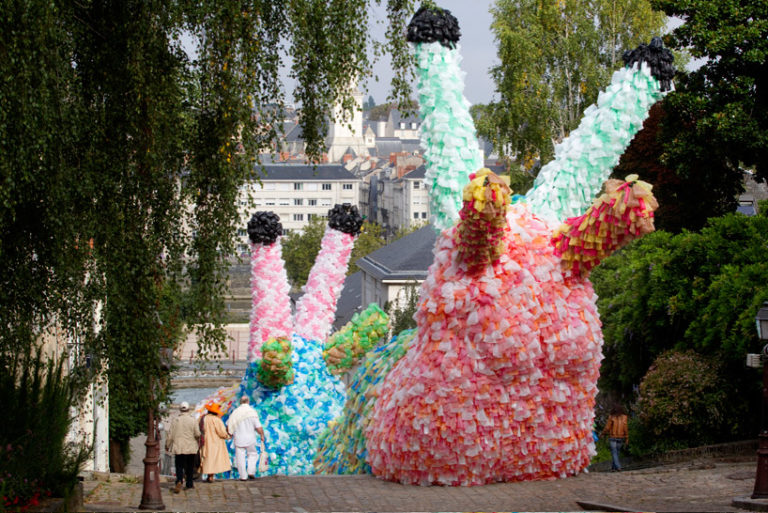 Florentijn Hofman, Slow Slugs, 2012. Photo: designboom.
Florentijn Hofman, Slow Slugs, 2012. Photo: designboom.
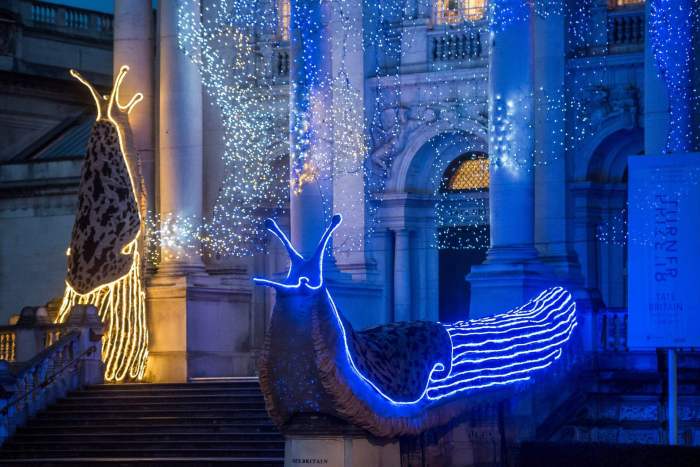 Monster Chetwynd, Tate Britain, 2018. Photo: Matt Greenwood © Tate.
Monster Chetwynd, Tate Britain, 2018. Photo: Matt Greenwood © Tate.
Why exactly scenes of knights fighting giant snails are seen so frequently throughout the margins of 13th- and 14th-century manuscripts remains a mystery. One theory is that the snails were initially intended to symbolize the Lombards—a once-powerful tribe of Germanic warriors conquered by Charlemagne in 774 CE. Upon defeat, the Lombards were forced to become pawnbrokers and lenders. This allowed them to retain some influence but they were unable to be armed. They were stereotyped as being greedy and cowardly, having a thin layer of protection on the outside but with a slimy and soft core. This projected power combined with latent impotence made them an excellent target for humiliation—and snails were the perfect caricature. From there, the image of the snail became a sort of meme, replicated by scribes again and again as a joke—a symbol of a generally squishy disposition.
Salvador Dali, who saw a snail outside Freud’s home just prior to meeting the psychoanalyst for the first time, supposedly associated Freud’s mind with a snail shell—hard on the outside, soft on the inside, and spiralling inward to the secrets at its core. Given Freud’s fixation with sexual dysfunction, Dali is said to have employed the snail as a symbol of impotence throughout his work. There is some irony to this association, however—because most species of gastropods are hermaphrodites, they are in fact very adept at reproducing. Within a species, any snail can mate with any other snail, and some can even reproduce asexually.
In 2013, Danish artist Lea Porsager presented her exhibition “Food for the Moon: Sluggish and Well-Lubricated” at the Henie Onstad gallery in Norway. The work was based on the science-fiction novel Beelzebub’s Tales to His Grandson by Armenian author and mystic G.I. Gurdjieff. The book is an intentionally complex allegory, but the primary plot follows Beelzebub, an extraterrestrial, as he observes humans from elsewhere in the solar system, at one point—in the pivotal moment on which Porsager’s work is based—mistaking them for slugs. Curator Milena Hoegsberg described “Food for the Moon”—which consisted of bronze abstract slug sculptures—as a “queer quantum shift away from a human-centric world view towards a slug-centric one, stumbling into the slimy entangled bosom of slug-occultism, sex magick and sci-fi spirituality” in which “the ambiguous nature of the slug embodies the potential of a space outside the usual dichotomies of male and female.”
When Young Joon Kwak visited the Banff Centre in 2018, they recognized the sexual fluidity of the hot springs snail and leveraged it in their contemplation of the radical potential of non-binary bodies. In Kwak’s exhibition “THE CAVE,” bronze representations of the snails—whose shells rotate counter to that of most other species—could be found in a fountain made of a mirrored security dome and encrusting disembodied hermaphroditic genitalia. The installation actively countered the aesthetic of the “man cave” in Kwak’s critique of male dominance in domestic spaces as well as the outdoor environment. Whether intentionally or not, it also subverted historically demeaning snail symbology that profiled the creatures as sexless and powerless. Kwak’s work acknowledged the exceptional nature of the snail, as well as its vulnerability within its habitat, to speak about the scrutinization and attempted regulation of marginalized, non-normative bodies.
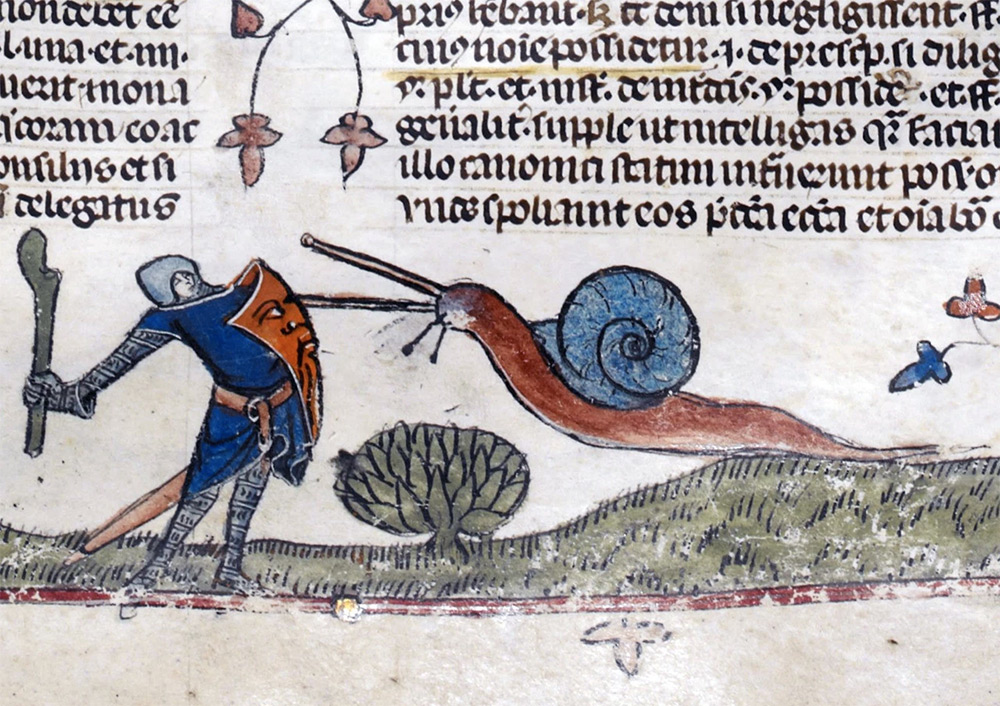 Snail fights knight in medieval manuscript. Photo: The British Museum.
Snail fights knight in medieval manuscript. Photo: The British Museum.
Halifax-based artist Anne Macmillan, who was an artist in residence at the Banff Centre in 2016, was also compelled to explore the relationship between curious tourists, the snails and their delicate environment. Macmillan produced a video work, titled This Place, which looked at the infatuous yet exploitative dynamic surrounding the snails and the pools where they live—the boundaries of which are often overstepped by visitors to the park. The animated work moves through a series of minimalist scenes accompanied by narrative text. In it Macmillan writes phrases like, “[The snail] carries a smaller mountain on its back…A creature of low impact…In contact with the ground.” Macmillan highlights the connection these creatures have shared with the earth for nearly 500 million years—literally unable to separate themselves from it. The work draws attention to what it means to be at the mercy of the environment, which in the current climate is rife with uncertainty, and even fear.
Similarly, Monster Chetwynd was inspired by seeing how her sluggish subjects coped in their natural habitat—although in her case it was through watching Life in the Undergrowth, a television documentary series narrated by David Attenborough. The episode she references is one in which bioluminescent leopard slugs are mating at night, “slowly rotating together, dangling from the branch of a tree by a glittering rope of mucus.” Chetwynd has a strong interest in alternative energy and has expressed excitement about the idea that light-emitting organisms may one day power street lights. She said she wants her slug sculptures, made from compostable materials, “to be fun and to spark discussion about where we source our energy.”
Although environmental concerns were not as politically fraught in the 1950s as they are now, Henri Matisse was attentive to the delicate and elegant balance of nature and its influence on aesthetic history. He created The Snail in 1953, with the help of an assistant, when he was bedridden from illness and could no longer paint. He had done realistic studies of snails previously and was fascinated by their concentric circles. In The Snail, Matisse abstracted this pattern using only cut pieces of paper with no outlines and spoke about freeing the animal from the confines of its shell. The work, with its employment of balanced colours and the golden ratio, speaks to harmonies and cycles within nature—a conceivable subject for an artist in the last year of his life.
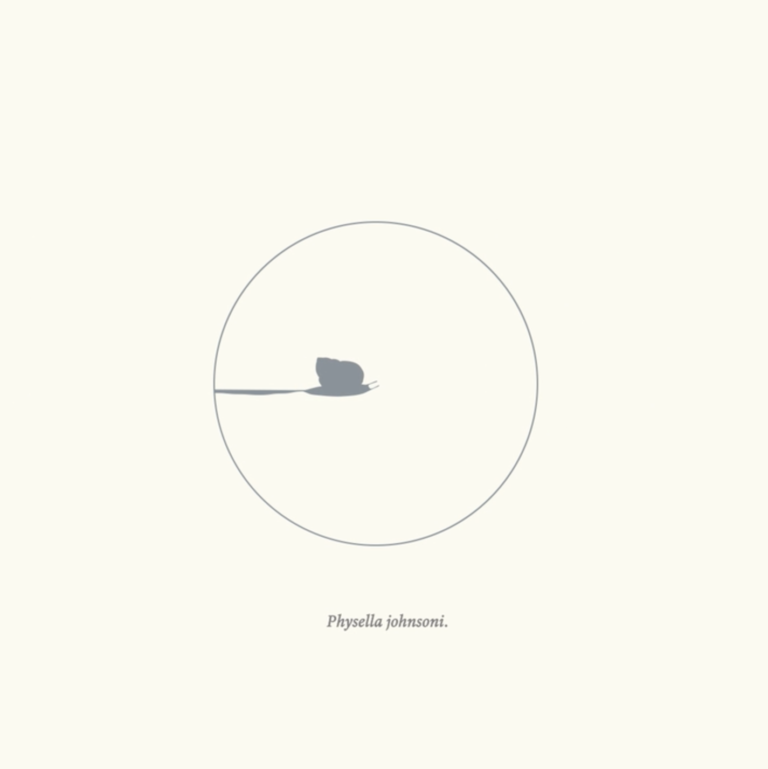 Anne Mcmillian, This Place (still), 2016. Animated video, 7 min 42 sec.
Anne Mcmillian, This Place (still), 2016. Animated video, 7 min 42 sec.
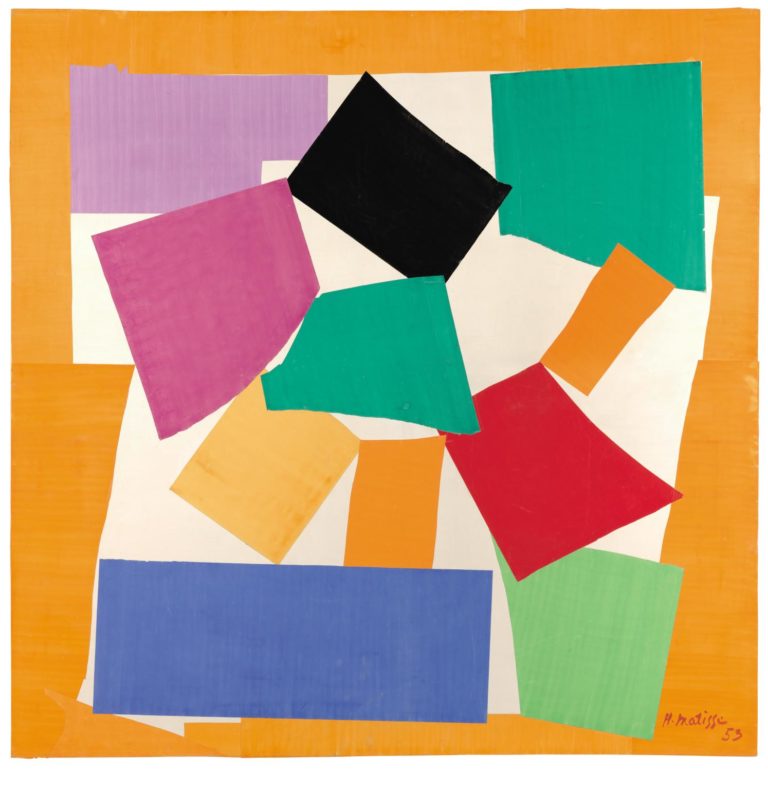 Henri Matisse, The Snail, 1953. Gouache on paper, cut and pasted on paper mounted on canvas, 286 x 287 cm. Courtesy Tate Britain.
Henri Matisse, The Snail, 1953. Gouache on paper, cut and pasted on paper mounted on canvas, 286 x 287 cm. Courtesy Tate Britain.
During the Dutch Golden Age of the 17th century, snails and slugs were used in still life paintings of flowers and fruit as memento mori, signifying that death and decay will eventually come to all living things. Snails are even featured as gargoyles on the apse of Gaudi’s Sagrada Familia in Barcelona alongside other animals frequently associated with decomposition. Most species of gastropods are scavengers, making them the ideal poster-boys for the slow and final process of decay before complete dissolution. They are small and unassuming, yet with ample time have the power to render something into nothing.
For Brooklyn-based artist Urs Fischer, snails symbolize time, process and transience. Snail imagery has been a part of Fischer’s work for several years, but his interest in the coiled creatures was highlighted in 2018 when his installation Maybe took centre stage at the Glasgow International biennial. In the expansive main gallery space of the Modern Institute, two fist-sized motorized snails crawled aimlessly in perpendicular circles on the floor to the delight of many visitors making their own rounds of the festival. The curatorial text for the installation attests that “their slow and steady pace reminds us of a life void of distractions and entertainment”—a return to stark consciousness in a busy and preoccupied world.
Peter Gazendam’s sweeping permanent public artwork in Vancouver comprises 40 bronze banana slugs spread throughout Columbia College’s downtown campus. The installation of the sculptures in Long Conversation (for Oona) range from discrete placements of realistically sized slugs to an unmissable face-off between two park bench–sized monsters in a public courtyard. The squishy, slimy bodies of the subjects are forged in gleaming bronze, reinforcing the heroism and power that Gazendam sees in them. He takes a transient animal, generally associated with decay, and renders it immortal and immoveable. Together the infestation tempts the fast-moving public with their slowness and stillness, encouraging viewers to ponder their own humility, endurance and mortality.
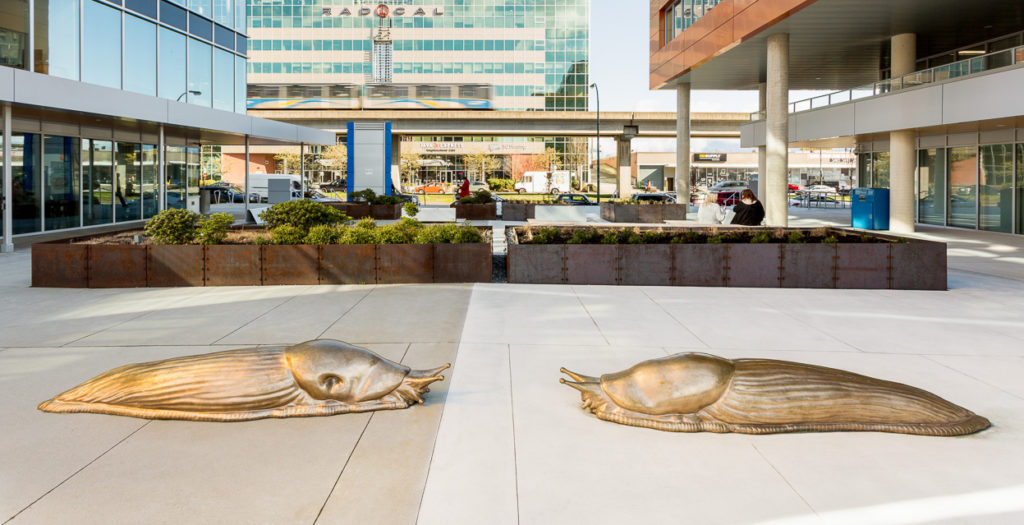 Peter Gazendam, Long Conversation (for Oona), 2017. Bronze. Photo: Blaine Campbell.
Peter Gazendam, Long Conversation (for Oona), 2017. Bronze. Photo: Blaine Campbell.
When so many people are chasing power only to leave others to scavenge for what’s left, when the health of the planet to which we are intrinsically tied is in peril and when we are all moving so quickly that we deny or dismiss any semblance of vulnerability in favour of progress and instant gratification, it makes sense that we would turn to snails and slugs for guidance. Their strange ancient forms make them seem almost extraterrestrial. In an age of information they are a welcome reprieve of mystery, weirdness, humility and absurdity, making it easier to think about heavy topics without the crushing existential dread. Their spinelessness is not a weakness but rather a symbol of flexibility and resilience—they’ve been getting stepped on for millions of years and they’re still going strong. Personally, I like to think these wondrous little animals persist in our public consciousness to remind us all to slow down, think about the longevity of our species rather than ourselves, appreciate our differences and protect our environment. But, with an ominous wriggle of their antennae, they aren’t about to let us forget that ultimately it will be them who get the last laugh.

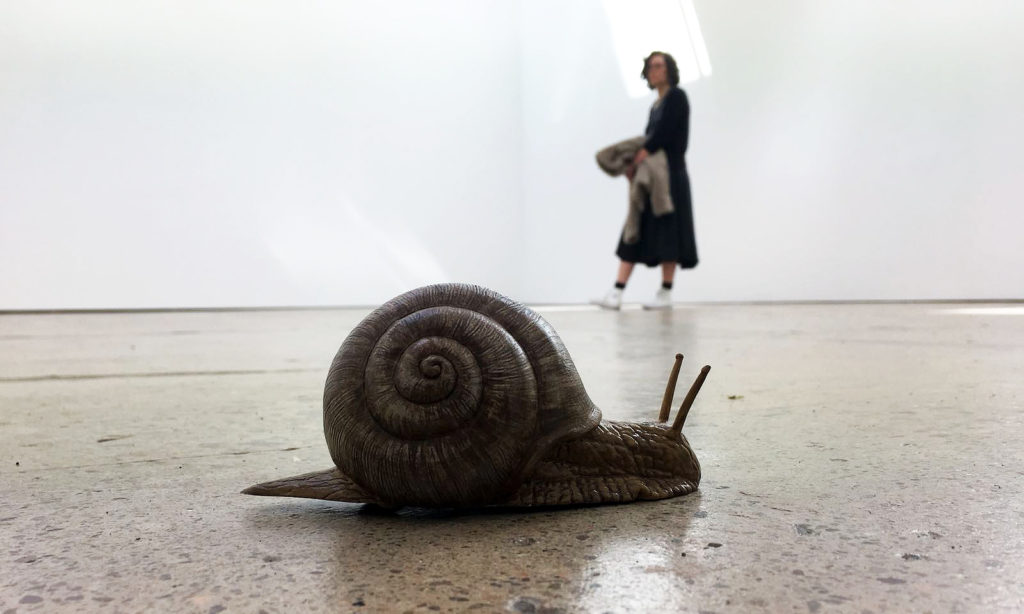 Urs Fischer, Maybe, 2018. Photo: Glasgow International.
Urs Fischer, Maybe, 2018. Photo: Glasgow International.

